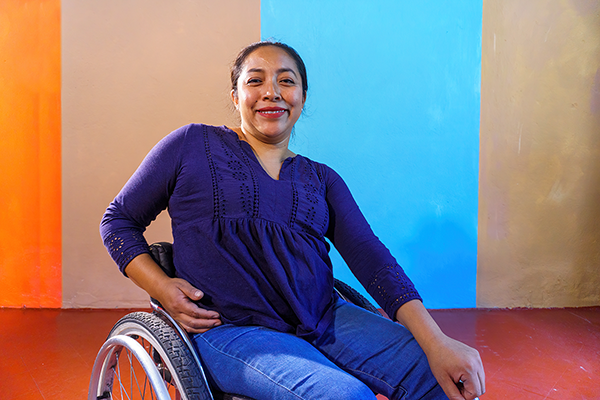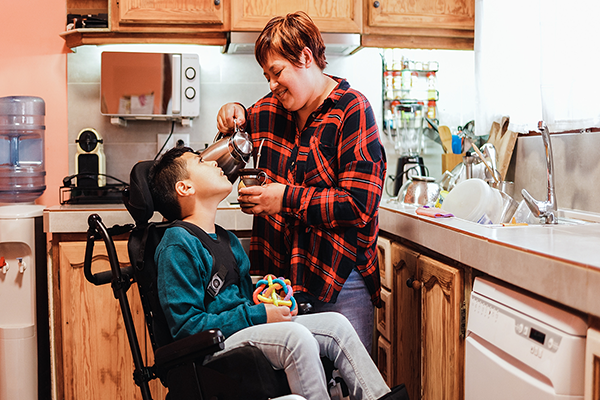There are many Spanish-speaking people in the U.S. In fact, 13% of people nationwide speak Spanish at home (U.S. Census Bureau, 2022). Like everyone else, Spanish-speaking people are protected by the ADA, a civil rights law that prohibits discrimination against people with disabilities. However, there is not much information about the needs of Spanish-speaking people and communities for access to information and technical assistance about the ADA.
On this webpage, you will learn about a wide-ranging project from the ADA National Network that aims to determine the best ways to support Spanish-speaking people in accessing their rights under the ADA.
Spanish Language Outreach (SLO) Project overview
The Spanish Language Outreach Project (SLO) is a five-year collaborative national initiative of the ADA National Network. The ADA National Network is made up of 10 regional ADA Centers and the ADA Knowledge Translation Center and provides technical assistance (TA), training, and informational materials to people with rights and responsibilities under the ADA. However, few Spanish-speaking people receive TA from the ADA National Network or use the Spanish-language website resources.
The goals of the SLO are:
- Develop a deeper understanding of the context of Spanish-speaking communities through research and expert consultation.
- Assess the diverse regional and national community needs of Spanish-language speakers in the U.S.
- Develop plans to reduce barriers to language access.
- Identify and develop knowledge translation interventions, products, and resources targeted to Spanish-language communities.
- Develop connections to new outreach partners and trusted community leaders to better support dissemination, training, and technical assistance.
The Spanish-speaking community in the United States

As of 2020, there were 62.1 million Hispanic, Latino, or Latina people in the United States. This population includes people of Cuban, Mexican, Puerto Rican, South or Central American, and Spanish descent. Of these communities, Mexicans are the largest group at 61%. States with the largest Hispanic/Latino populations include California, Texas, Florida, New York, and Arizona (U.S. Department of Health and Human Services Office of Minority Health, 2023). Hispanics and Latinos are also one of the fastest-growing populations in the country. In the last decade, the Hispanic population increased by 23% (Pew Research Center, 2022). Nationwide, 13% of people (over 14 million people) in the United States speak Spanish at home. After English, Spanish is the most common language spoken in the U.S. (U.S. Census Bureau, 2022).
The Hispanic and Latino population in the U.S. has rapidly grown for several decades and is one of the fastest-growing ethnic groups. Within this diverse population, many communities have continued to face substantial barriers to full inclusion in everyday life. Some of the barriers or challenges are connected to limited access to employment, education, and legal services. Outreach to educate community members about their legal rights is an essential part of removing these barriers and addressing discrimination. Hispanics and Latinos with disabilities face inequalities and barriers when accessing information in various areas of life.
What is the ADA and the ADA National Network?

The ADA is a civil rights law that prohibits discrimination against individuals with disabilities in many areas of public life, including jobs, schools, transportation, and many public and private places that are open to the general public. The purpose of the law is to make sure that people with disabilities have the same rights and opportunities as everyone else. The ADA gives civil rights protections to individuals with disabilities similar to those provided to individuals on the basis of race, color, sex, national origin, age, and religion. It guarantees equal opportunity for individuals with disabilities in public accommodations, employment, transportation, state and local government services, and telecommunications.
The ADA National Network provides information, guidance, and training on how to implement the Americans with Disabilities Act (ADA) to support the mission of the ADA to “assure equality of opportunity, full participation, independent living, and economic self-sufficiency for individuals with disabilities.” Funded by the National Institute on Disability, Independent Living, and Rehabilitation Research (NIDILRR), the network consists of 10 regional ADA Centers located throughout the United States and the ADA Knowledge Translation Center. Each regional ADA Center focuses on its region’s unique needs. This regional focus is critical to ensuring that ADA National Network services meet the needs of a diversity of populations and stakeholders throughout the country.
Why is the ADA important for Spanish-speaking communities?

As the Hispanic/Latino population continues to grow in the United States, the number of people with disabilities in these communities has also increased. In 2022, there were 5.9 million Hispanic or Latino people with disabilities in the United States (U.S. Census Bureau, 2022). Despite the growth of the population across the country, Hispanic/Latino people continue to face underrepresentation and access disparities in areas such as education, health care, employment, and civil rights. For Hispanic/Latino people with disabilities, there are additional barriers as they simultaneously navigate cultural and health-related differences. These barriers include language barriers, lack of access to information, immigration status, discrimination, and fear, among many others. These barriers affect access to information.
SLO stage 1: Understanding the national and regional contexts
The first stage of the SLO project (2022-2023) aimed to address goal 1: to develop a deeper understanding of the context of Spanish-speaking communities and assess their ADA-related information needs through research and expert consultation. Two sets of interviews were conducted: “national” interviews with leaders working directly with Spanish-speaking and/or disability communities and “regional” interviews with community members living with or without disabilities that are a part of, work with, or are involved with members of the Spanish-speaking community.
At the national level, 14 leaders working directly with Spanish-speaking and/or disability communities from nine national organizations participated. Most of the 46 regional participants were members of the Spanish-speaking community living with or without disabilities. A few participants worked in programs or organizations that provided services to Spanish speakers. Most regional participants identified as a parent of someone with a disability, person with a disability, community resource manager, or director of programs at their organization.

People who were interviewed reported barriers that Spanish-speaking communities face and how they access and share information. They also gave suggestions to improve outreach efforts.
The national and regional reports below present the results from the first stage of the project and includes the following main sections:
- Background and national context.
- The findings from qualitative interviews conducted with national organizations that work with Latino communities and/or with people with disabilities.
- A synthesis of the regional findings.
- Individual regional findings outlining the context and qualitative interviews conducted with community members of Spanish-speaking communities in each region.
- A summary of the key findings and recommendations of the first stage of the project.
Read the SLO Stage 1 Reports and Infographics
SLO stage 2: Increasing language access to information about the ADA
The second stage of the SLO (2024) addresses SLO goal 3 (develop plans to reduce barriers to language access) and goal 4 (identify and develop knowledge translation interventions, products, and resources targeted to Spanish-language communities). The importance of language access was already known as a barrier that prevents people from accessing health care and other social services. Increasing language access is a priority of the federal government, including the Department of Health and Human Services. Many of the SLO Stage One interviews revealed significant challenges to understanding disability rights and the ADA resulting from language barriers.
Considering this finding, a series of videos in Spanish and English was developed to address basic information about cultural understandings of disability and civil rights and to increase language access to ADA information and resources. The videos in this series are intended for Spanish-speaking community members as well as those who provide services, resources, and support for individuals in the Latino community. The videos in the series are:
- Introduction to the Video Series.
- Disability, Stigma, and Language.
- Barriers for the Latino Community.
- Introduction to Rights.
- Introduction to the Americans with Disabilities Act (ADA).
- Role of Community Members.
Watch the SLO Stage 2 Video Series
ADA National Network Spanish publications
Check out the ADA National Network products available in Spanish and listen to this podcast in Spanish about how the ADA National Network is connecting with Hispanic and Latino communities with disabilities.
Resources and references
Passel, J. S., Lopez, M. H., & Cohn, D. V. (2022, June 17). U.S. Hispanic population continued its geographic spread in the 2010s. Pew Research Center. https://www.pewresearch.org/short-reads/2022/02/03/u-s-hispanic-population-continued-its-geographic-spread-in-the-2010s/
U.S. Census Bureau. (2022). Disability Characteristics – United States [S1810]. Retrieved from https://data.census.gov/table/ACSST5Y2022.S1810?q=s1810
U.S. Census Bureau. (2022). Language Spoken at Home – United States [S1601]. Retrieved from https://data.census.gov/table/ACSST1Y2022.S1601?q=langauge&g=010XX00US
U.S. Department of Health and Human Services Office of Minority Health (2023, February 24). Profile: Hispanic/Latino Americans. HHS.gov. https://minorityhealth.hhs.gov/hispaniclatino-health

.png)




